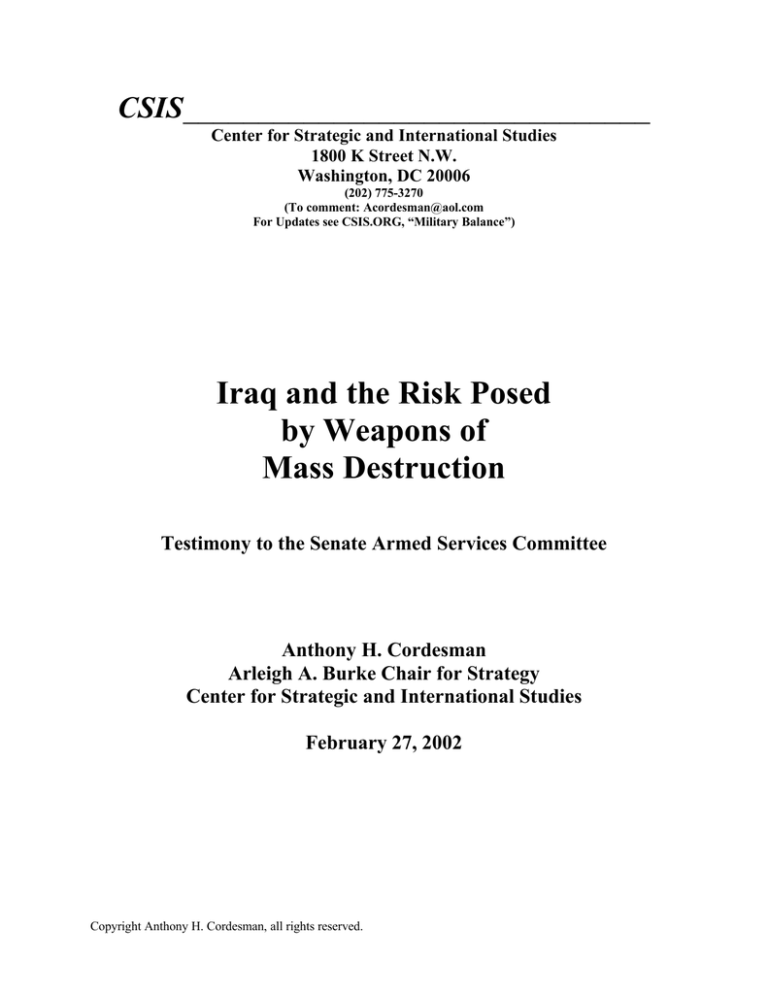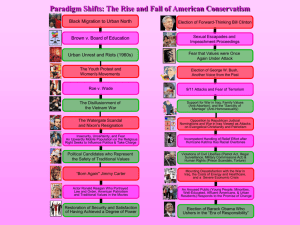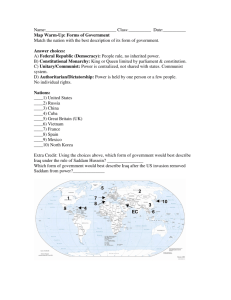
CSIS_______________________________
Center for Strategic and International Studies
1800 K Street N.W.
Washington, DC 20006
(202) 775-3270
(To comment: Acordesman@aol.com
For Updates see CSIS.ORG, “Military Balance”)
Iraq and the Risk Posed
by Weapons of
Mass Destruction
Testimony to the Senate Armed Services Committee
Anthony H. Cordesman
Arleigh A. Burke Chair for Strategy
Center for Strategic and International Studies
February 27, 2002
Copyright Anthony H. Cordesman, all rights reserved.
Cordesman: Iraq and the Risk Posed by Weapons of Mass Destruction
2/28/02
2
At this point in time, no unclassified source can hope to accurately characterize Iraq’s
current holdings of weapons of mass destruction or the rate at which it can improve its present
capabilities. At the same time several facts are clear. Iraq has a long and well-documented
history of acquiring and using weapons of mass destruction. (This history is summarized in
Attachment One.) In fact, proliferation has now been a major Iraqi objective for well over a
quarter of a century.
Iraq’s History of Proliferation
Iraq’s attempts at proliferation date back to at least the time of the October War in 1973,
and it actively sought nuclear weapons for several years before the Israeli strike on its Osriak
reactor in 1981. It stepped up its efforts to acquire chemical and biological weapons after it
suffered its first serious round of reversals in the Iran-Iraq War in 1982, rushed to use chemical
weapons as soon as it could deploy initial amounts of mustard gas, and escalated to far more
serious uses of chemical weapons before the Iran-Iraq War ended.
It chose to use chemical weapons against its own Kurds when some supported Iran. It
rushed biological weapons forward at the same time, and it seems virtually certain that it would
have used them if it has not defeated Iran so decisively in the spring of 1988. It rushed extended
range Scuds into deployment and conducted a major missile campaign against Iran’s cities,
developed chemical and biological warheads for its missiles, and develop a family of much
longer-range/higher payload missiles.
Iraq prepared to make massive use of chemical weapons during the Gulf War in 19901991, and disbursed its biological weapons so that they could be used in air strikes. It carried out
a major series of conventional missile strikes on Israel and Saudi Arabia and prepared a “launch
under attack” option to use chemical and biological weapons if the leadership was threatened or
saw a broad defeat as inevitable. It rushed forward its nuclear program, attempting to build at
least a few weapons by the early 1990s. It refined biological weapons for agricultural attacks as
well as attacks on human beings and looked at alternative means of delivery such as drones, crop
sprayers, and helicopters.
Sustaining these programs during the 1980s and through 1991 cost tends of billions of
dollars at time when Iraq was effectively bankrupt and dependent on other Gulf states for its
Cordesman: Iraq and the Risk Posed by Weapons of Mass Destruction
2/28/02
3
financial and military survival. The programs were massive in scale, and involved the
development of delivery systems with far longer-ranges than were needed simply to cover Iran.
They were part of an equally massive conventional military build up, and seem to have been
directed at regional dominance, not simply the defeat of Iran and invasion of Kuwait. They
clearly would have given Iraq a capability to target Israel and Turkey and every US base in the
region with the exception of Diego Garcia.
The Gulf War did surprisingly little damage to either Iraq’s missile programs or any of its
chemical, biological, radiological, and nuclear programs. The most damaging single US strike
was an accident when an aircraft struck a secondary target selected for other purposes. The US
lacked the ability to effective target Iraqi CBRN and missile facilities and forces because of the
highly covert nature of Iraq’s programs – a problem the US had not solved when it carried out
equally ineffective strikes in December 1998 as part of Operation Desert Fox and in spite of
eight years of UNSCOM inspections.
Ever since the end of the Gulf War, Iraq has made its missile and CBRN programs its
highest single national priority. It has been willing to accept more than a decade of continued UN
sanctions, to suffer follow-on US and British air strikes, to cripple its economic development and
cause massive suffering for its people, and see its conventional forces massively deteriorate
because of its lack of conventional arms imports. (The cost and nature of the deterioration in
Iraq’s conventional forces is shown in Attachment Two). In fact, there are strong indications that
Iraq not only did everything possible to retain its pre-Gulf War capabilities in spite of UNSCOM
inspections, but created new, high compartmented, black programs in case UNSCOM could
succeed in tracking down all of the programs in had in place in 1991.
Iraq has lied to the UN and the world every time this helped it to preserve its CBRN and
missile weapons and facilities, and has been willing to suffer repeated diplomatic
embarrassments in the process. The biggest of these lies was its denial of a massive biological
weapons program between 1991-1995, but it has lied about its missile, chemical weapons, and
nuclear weapons programs as well. It has been repeatedly caught important or attempting to
import dual-use items and CIA and Department of Defense reporting makes it clear that it
continues to do to this date.
The Certainty of a Continuing Threat
Given this background, several things become clear:
Cordesman: Iraq and the Risk Posed by Weapons of Mass Destruction
•
2/28/02
4
Iraq is ruled by a regime of proven liars that will lie again whenever this is
convenient.
•
Iraq will never cease proliferating as long as the present regime is in power.
•
Iraq does not perceive any moral or military “redlines” that will prevent it from using
CBRN weapons if it feels this is expedient.
•
Iraq will continue to try to develop long-range missiles but has long had other
delivery options and will almost certainly continue to improve them.
•
Iraqi proliferation will not be tied to one type of weapon of mass destruction. It will
seek chemical, biological, radiological, and nuclear weapons.
These points in some ways make Iraq’s current missile and CBRN capabilities moot. The
issue is not whether Iraq has yet achieved nuclear weapons or extremely lethal biological
weapons, or even whether it will indulge in another round of UN inspections. It is that this regime
will eventually acquire nuclear weapons and biological weapons with equal or greater lethality if
it is given the time and opportunity to do so. It also will not change character or somehow enter
the mythical “family of nations.” Its leadership has a grimly consistent record and set of goals,
and the sons of Saddam Hussein have made it clear that Iraq has not even made a convincing
public attempt to give up its claims to Kuwait or any of its either regional ambitions.
Key Uncertainties
At the same time, it is important to make several caveats about Iraqi capabilities and
intentions:
•
Iraq has been more reckless than pragmatic in the past, and its leadership must fully
understand the risks of using such weapons. However, Iraq’s conventional weakness
pushes it towards the threat or use of CBRN weapons, and Saddam Hussein took
massive risks in invading Iran and Kuwait.
•
No one outside the intelligence community and possibly within it can predict the
point at which Iraq will get deliverable nuclear weapons or predict their yield and
lethality.
•
The same is true of highly lethal dry storable biological weapons, and of variants that
are genetically engineered or have no effective medical treatment.
Cordesman: Iraq and the Risk Posed by Weapons of Mass Destruction
•
2/28/02
5
Without an actual test or series of tests, neither we nor the Iraqi leadership can predict
the lethality of a nuclear or biological weapon, of the reliability, accuracy, and
efficacy of any given means of delivery. (The technical and historical data the US has
on weapons effects and lethality are not reliable enough to do more than speculate in
these areas and errors of more than an order of magnitude are possible.)
•
Iraq may or may not have the smallpox virus and the ability to conduct a major
infectious attack using covert or asymmetric means. Such an attack could, however,
have nuclear lethalities and might be undetectable until it was well underway.
•
Iraq has the technical capability to use a combination of strike aircraft and/or residual
missile forces to create a launch on warning or launch under attack capability.
•
Iraq could probably covertly or directly mount a CBRN/missile attack on US forces
in Gulf ports, key facilities in Southern Gulf states, and/or Israel.
•
Iraq does not have an extensive known history of using terrorist organizations or
proxies, but does have associations with them, and there are no major barriers to such
attacks. A covert and/or unattributable attack is possible, particularly under false flag
conditions or ones where Iraq might be able to piggyback on an attack by a known
terrorist group.
•
Other nations, such as Iran, might in turn conduct false flag attacks designed to
implicated Iraq.
•
Iraq may have the capability to attack agriculture as well as humans.
•
There is no way to determine how third countries would react to the threat or reality
of an Iraqi CBRN attack until the event occurs. An Iraqi regime in extremis might
attack nations like Kuwait, Israel, and Saudi Arabia either out of revenge or it an
effort to broaden the conflict and preserve the regime.
The four most serious uncertainties, however, are not matters of what weapons Iraq has
or how it might use them, but rather ones relating to the strategic options open to the US. First,
they are whether US containment can be successful in preventing Iraq from exploiting its CBRN
capabilities. If the US should lose its ability to enforce Northern and Southern watch and freedom
of action in striking at those Iraqi capabilities it can identify, the answer is clearly no. The same
may well be true if UN sanctions erode to the point where Iraq has much greater freedom of
action in importing dual use items.
Cordesman: Iraq and the Risk Posed by Weapons of Mass Destruction
2/28/02
6
The second uncertainty is whether any new round of UN inspections can really be
successful in stopping Iraqi proliferation. The answer is probably no. They might well be able to
stop Iraq from major development of missiles and their deployment, large-scale production of
chemical weapons, and producing fissile material in any significant amounts. They cannot affect
Iraq’s technology base, they cannot hope to detect a covert biological program with nuclear
lethalities, and they cannot hope to prevent Iraq from assembling a nuclear device if it can obtain
fissile or “dirty” fissile material from outside Iraq. In fact, efforts directed at large, observable
Iraqi CBRN and missile activities may simply push Iraqi into concentrating on biological
weapons and asymmetric means of delivery.
Third, it is uncertain that the US can now do a more effective job of targeting Iraqi
missile and CBRN facilities and weapons than it did during the Gulf War and Desert Fox, in spite
of the impressive advances in US targeting and strike capabilities demonstrated in Kosovo and
Afghanistan. Iraq is expert at camouflage, deception and the use of decoys, exploits dispersal and
movement (shell games), creating duplicate and back-up systems, and creating small covert
facilities. Preserving such residual capabilities would be particularly important in the case of
biological and nuclear weapons.
Finally, the US cannot count on Iraq ceasing to proliferate simply because of regime
change – even if the new regime initially appears to do so. Iraq is a highly nationalistic country
that exists in a region where Iran, Israel, Pakistan, India, Syria, and Egypt are also proliferators.
As is the case with a number of Asian powers like South Korea and Taiwan, Iraq may at a
minimum preserve a sudden breakout capability in an area like biological weapons almost
regardless of regime.






